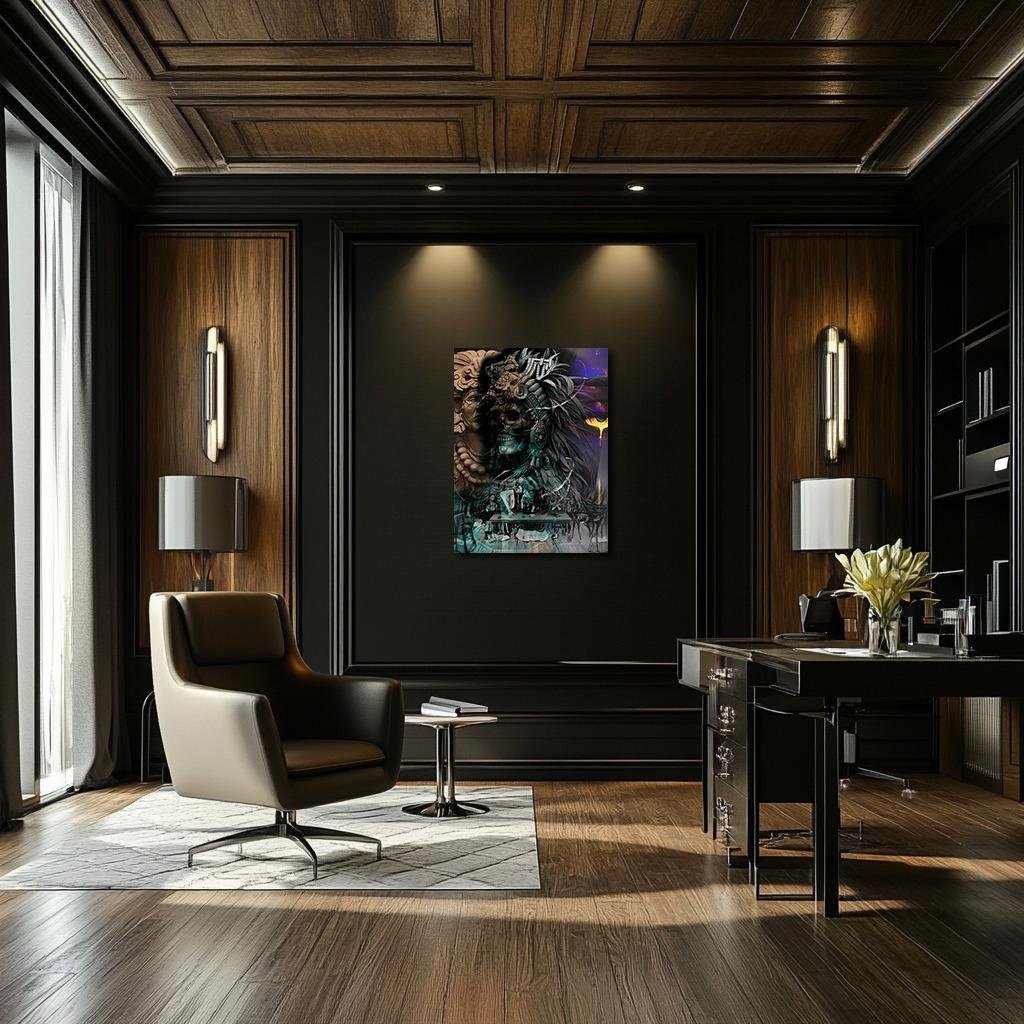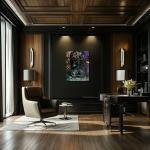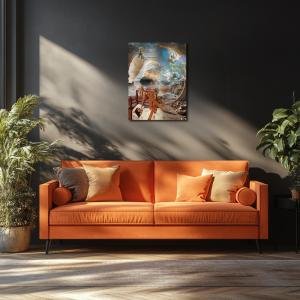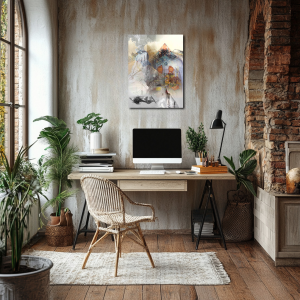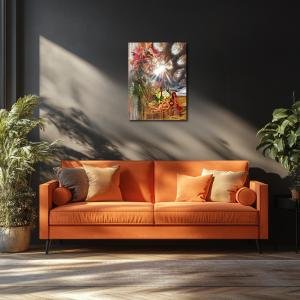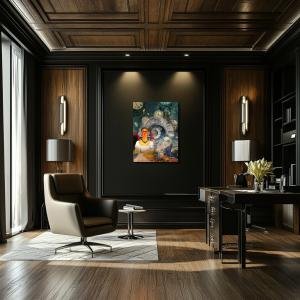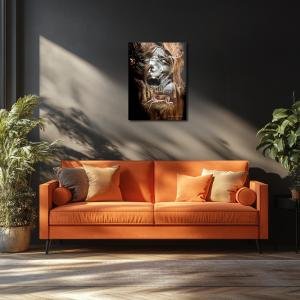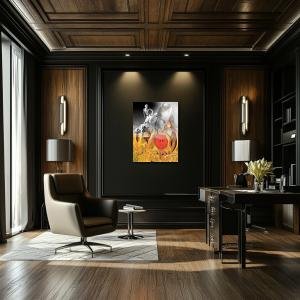The Banquet of Shadows: Frida’s Ritual of Loss and Rebirth
The Banquet of Shadows reimagines Frida Kahlo’s The Wounded Table as a sacred rite of pain, ancestry, and cosmic judgment. With obsidian blacks, rust-reds, sepias, and ancestral turquoise, this piece merges the bleeding table with gods of death and memory, casting Kahlo as both priestess and sacrifice. A skeletal deity towers behind her, feathers dark as night, while figures of myth and mourning gather in a ceremonial blur. This is not a dinner—it is a summoning, where Frida offers herself to history, and the shadows answer with silence.
Please see Below for Details…
Hotline Order:
Mon - Fri: 07AM - 06PM
404-872-4663
This conceptual reimagining of Frida Kahlo’s The Wounded Table descends into a mythic theatre of grief, identity, and ceremonial sacrifice, where the feast becomes a funeral and the self is not merely split—but offered. Titled The Banquet of Shadows , the composition gathers gods, spirits, skeletons, and fragments of Kahlo’s psyche at a dark ceremonial table, surrounded by the echoes of ancient empire and colonial fracture. Here, Kahlo does not simply depict her pain—she orchestrates it as a ritual for the dead, a pageant for those who bear memory as burden.
At the visual core lies the wounded table itself—dark, cracked, and bleeding. Kahlo leans forward at its center, her elbows firm, her eyes unsparing, her torso stiff like an altar. But in this vision, she is not alone. The table’s surface becomes a threshold, summoning from below the ceremonial spirits of Mesoamerica, death gods of obsidian bone and feathered headdresses who rise through ink and smoke to tower over her presence. One skeletal deity, adorned in quetzal feathers and jade earrings, leans closest—a silent sentinel of decay and continuity.
Behind and beside Frida, the figures from the original painting—her pet deer, skeletons, papier-mâché figures—blur into ghostly attendees. They no longer resemble puppets or caricatures but appear etched from charcoal, scorched onto wood, like stories retold across generations. Their hands rest on the table with quiet tension, as if waiting for the cut, the verdict, the end of ritual time.
To the left, the soft contour of an Aztec or Mayan stone sculpture looms, chiseled in warm sandstone and wrapped in shadows. It gazes forward, its lips frozen mid-chant. A reminder of ancestry—unmoved, but watching. On the right, the black feathered plume of death rises like a storm, encasing the composition in nocturnal force. The skeletal god that emerges from this mass is rendered in shades of blue-green, serpentine and regal, holding in its sockets both mourning and inheritance.
Color in The Banquet of Shadows is layered in dusk and blood. The palette begins in rich sepia, copper, and dusky ochre—colors of wood, time, and dried earth. The table itself absorbs these hues, appearing carved from mahogany soaked in history. Overlaid on this base is a deep obsidian black—used to define the death god’s feathers, Kahlo’s hair, and the shadows that leak from every corner of the scene. Black is not emptiness here—it is weight, memory, and consequence.
Kahlo’s face is painted in lifeless olive and pallid rose, her cheeks faded as if the blood has left them long ago. The contrast between her red dress and her pale flesh is stark, echoing both sacrifice and survival. Her mouth is firm, unparted—a dam against collapse. Around her, the wounded table bleeds red—not bright or fresh, but rusted, dark, nearly brown, as though time has thickened the wound.
The skeletal deity is composed in a ghostly blend of turquoise, moonlight gray, and deep cerulean. These are not lively blues—they are the hues of grave soil, frozen rivers, and ceremonial paint worn in funerals. The golden streaks that flicker in its headdress and bones flicker like lost divinity—echoes of what was once venerated, now relegated to myth and memory.
The edges of the canvas fade into a violet-black veil, broken only by a yellow-gold tear at the far right—a symbolic gash in the spiritual membrane, bleeding inward like revelation or intrusion. Through this tear, the viewer is reminded: this table is not sealed. The dead speak. The living answer.
When I created The Banquet of Shadows , I wanted to transform Kahlo’s The Wounded Table from a surreal gathering into a mythopoetic council—a place where her pain and identity are judged not by others, but by the gods of her ancestors and the ghosts of her selves. Kahlo’s life was a wound she painted again and again—not to be pitied, but to be understood as sacred process. Her table was not a dinner setting—it was an altar. And here, that altar has expanded into a ritual of cosmic reckoning.
The composition’s rhythm is triadic: from the ancient stone gaze, to the skeletal god’s presence, to Kahlo’s form in still resistance. The viewer is pulled across centuries and spiritual registers, invited to kneel at the table and witness the offering of memory, identity, and history itself.
In this vision, Frida Kahlo is the wounded, the priestess, and the sacrifice. She dares to sit where gods once fed and dares to bleed where no one dares look. Her art becomes not a confession, but a ceremony—one that turns suffering into lineage and brokenness into eternal flame.
Add your review
Your email address will not be published. Required fields are marked *
Please login to write review!
Looks like there are no reviews yet.

